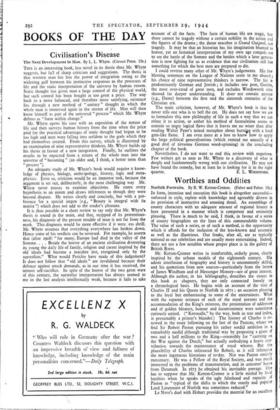Worthies and Oddities
Norfolk Portraits. By R. W. Ketton-Cremer. (Faber and Faber. 15s.) IN form, intention and execution this book is altogether successful— unforced in style, replete with knowledge and agreeably diverse in its provision of instructive and amusing detail. An assemblage of county characters with an adequate amount of regional history is here presented in a manner which is competent and eminently pleasing. There is much to be said, I think, in favour of a series of county biographies on the lines of this commendable volume. The value of such a series, or of such a method, is the opportunity which it affords for the inclusion of the less-known and eccentric as well as the illustrious. Our freaks, after all, are as typically national as our celebrities and are usually more entertaining. Indeed, there are not a few notables whose proper place is in the gallery of British Bores.
Mr. Ketton-gremer writes in comfortable, orderly prose, clearly inspired by the urbane models of the eighteenth century. His adroit' interfusion of biography and history is uncommonly skilful, and his quotations from new sources—particularly from the letters of James Windham and of Messenger Monsey—are of great interest. Although the author, in his bibliography, describes the essays in this book as chapters, they are only connected loosely on a chronological basis. He begins with an account 'of the visit of Charles II and his Queen to Norfolk in 1671 ; an occasion pleasing to the loyal but embarrassing to some of the entertainers. What with the separate retinues of each of the royal persons and the accommodation of the King's mistress, the presentation of addresses and of golden bloaters, honour and inconvenience were sometimes curiously united. ("Keroualle," by the way, both in text and index, is presumably a printer's blunder.) The history of Charles is re- newed in the essay following on the last of the Pastons, where we find Sir Robert Paston pursuing his rather sordid ambition in a remarkably sordid although traditional way by proposing a grant of two and a half millions to the King—ostensibly for " carrying on the War against the Dutch," but actually embodying a heavy con- tribution towards the maintenance of royal whores. But the plausibility of Charles infatuated Sir Robert, as it still infatuates the more ingenuous historians of to-day. Nor was Paston entirely mercenary. He was a Fellow of the Royal Society, and was much interested in the problems of -transmutation, and in unicorns' horns from Denmark. In 1673 he obtained his inevitable peerage. One has to suppose that Mr. Kelton-Cremer is a little misled by local loyalties when he speaks of the ugly falsehood and rapacity of Paston as "typical of the shifts to which the stately and popular Lord Lieutenant of Norfolk was sometimes reduced."
Le Neve's duel with Hobart provides the material for an excellent 'essay, showing the perils which beset a duellist who was so fortun- nate, or so unfortunate, as to kill his man. This is followed by the financial adventures of the Windham family in 172o, when the South Sea Company was turning the heads of investors in a whirl of giddy inflation.
Of the three purely biographical essays—those on Dr. Messenger Monsey, Benjamin Stillingfleet and Richard Gardiner—I prefer the second. There was never a more completely amiable person than Mr. Stillingfleet of the blue stockings. Apart from his unhappy love affair with Anne Barnes, there was little in his life that was not accordant with his placid, easy, studious temper. Monsey, on the other hand, is one of the unpleasant oddities of the eighteenth century. He was a professional shocker of elegance, practising the blatant and overbearing rudeness of repartee of which Dr. Johnson was the unapproachable master. But the rudeness of Johnson, if never wholly excusable, was generously amplified with learning and wit ; while the rudeness of Monsey was merely stupid and offensive. Perhaps Richard Gardiner is even more unpleasant. He is described by Mr. Ketton-Cremer as " a busybody, a sponger and a cad." These epithets are entirely justified, and I do not see why Mr. Ketton-Cremer his given him nearly thirty of his pages, for Mr. Gardiner, as well as being a cad, was also a bore.
The final essay (or chapter) deals with Norfolk under threat of invasion in 1757 and 1803. The parallel between 1803 and 1940 is remarkably close, and Mr. Ketton-Cremer, himself a Home Guard officer, gives an excellent account of the measures taken by Wind- ham to raise and equip a body of men for local defence. The ladies of Lynn made warm underclothing for the Volunteers, the question of gaiters received adequate attention, the effect of wind on the beaches was carefully noted, and a phase of energy- was followed in due course by a phase of growling boredom. This is by no means a book for Norfolk readers only : it is a book for intelligent readers everywhere.
C. E. VULLIAMY.



























 Previous page
Previous page